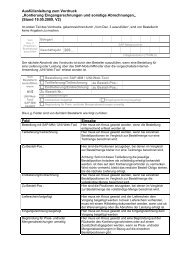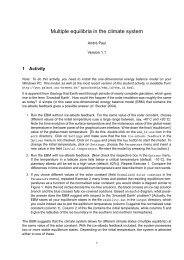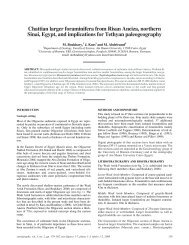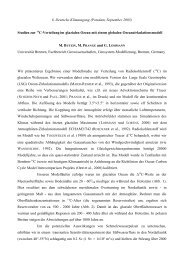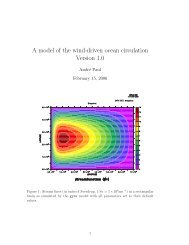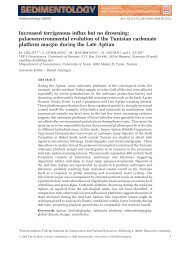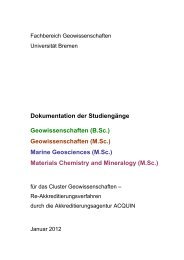Forschung im HLRN-Verbund 2011
Forschung im HLRN-Verbund 2011
Forschung im HLRN-Verbund 2011
- Keine Tags gefunden...
Erfolgreiche ePaper selbst erstellen
Machen Sie aus Ihren PDF Publikationen ein blätterbares Flipbook mit unserer einzigartigen Google optimierten e-Paper Software.
124Rise and Roll3D Modeling of Hydrothermal PlumesM. Walter, Y. Tao, Universität Bremen; Jacobs UniversityAbstract• Hydrothermal plumes along mid-ocean ridgesare crucial mechanisms by which Earth’s crusttransports heat and chemical components intothe ocean.• Data obtained by direct measurement of theplume is not sufficient to answer a slew of crucialquestions so we ask help from numerical model.• We developed a 3D t<strong>im</strong>e-dependent model tostudy the relation between plume heat flux andrising height and to investigate their 3D velocityprofiles.• The model has provided results with good agreementwith other models and measurements, italso shows great potential in future study.Hot deep-sea springs along mid-ocean ridges, socalledhydrothermal vents, are crucial for transportingheat and chemical components from insidethe Earth’s crust into the ocean. Data obtainedby direct measurement are not sufficient toanswer many crucial questions regarding the physicaldynamics of the plumes of such hydrothermalvents. To study the spatial and temporal dynamicsof such hydrothermal plumes we have developeda t<strong>im</strong>e-dependent fully three-d<strong>im</strong>ensional model,which explores the relation between the plume’sheat flux, rising height, and rising velocity for realisticenvironment configurations.Hydrothermal fluids are generated, when seawatercomes into contact with deeper layers ofthe Earth’s crust at areas, where tectonic platesare moving apart, the so-called sea-floor spreadingaxes. There the water is charged with heat andvarious chemical substances and is subsequentlyre-injected into the ocean. When this mineralenrichedwater, which can reach temperatures ashigh as 400 ◦ C, is ejected from the ocean floor intothe near-freezing sea water, the minerals precipitateand form a plume of colored, mostly black, fluid(see Fig.1, left panel). This black plume is the reasonwhy such hydrothermal vents are often called”black smokers”.The physical dynamics of such plumes are characterizedby the shear flows between the hot buoyantrising fluid and the cold ambient water columnof the surrounding ocean, which produce a lot ofturbulence such as vortexes and eddies. Theseturbulence phenomena facilitate the mixing of thecold ambient water with the hot fluid, resulting in acontinuous dilution of the original vent fluid. As theplume cools down while it rises, the buoyancy decreasesuntil a neutral layer is reached, where theambient water has the same density as the plume.The knowledge about heat and material flux outputfrom hydrothermal vents, which provide quite asignificant portion of the overall global flux, couldbe significantly <strong>im</strong>proved if the output and fluxmechanisms of individual vents were better understood.The buoyancy-driven turbulence and its resultingmixing effects, however, have always beenthe main challenge in understanding these processes.Most of the current est<strong>im</strong>ations of hydrothermalvent output are based on very s<strong>im</strong>pleone-d<strong>im</strong>ensional model developed half a centurybefore [1]. These approaches have distinct l<strong>im</strong>itationsas they cannot handle realistic environmentalfactors such as background current and irregularsea-floor topography.With our t<strong>im</strong>e-dependent numerical 3D modelwe a<strong>im</strong> at solving these kinds of problems. Asa first test we configured our model for s<strong>im</strong>pleenvironments such as those used in the oned<strong>im</strong>ensionalmodel [1] and compared the resultsfor the position of the layer of neutral buoyancy calculatedby both models. The results were in verygood agreement, which proves that our model ingeneral correctly describes the dominant fluid dynamicprocesses and therefore is ready to be appliedto more complex and thus realistic environmentconfigurations.The technical progress of recent years in exploringhydrothermal plumes, such as sonars thatrecord acoustic 3D <strong>im</strong>ages or even Doppler velocityprofiles of plumes, allow for much more detailedinformation about the inside plume structure [2].Before this new technology was available, this wasnearly <strong>im</strong>possible, because optical cameras wereobstructed by the particle clouds and thereforecould only observe the outer plume boundary. Withour model we can now calculate the fluid velocityand plume diameter from such acoustic measurements.By combining those data with informationobtained by chemical samples of the hydrothermalfluid itself and other physical in-situ measurements,we can calculate the heat and chemical flux of hydrothermalplumes semi-directly and thus substantiallyreduce the margin of error compared to othermodels.In summary, our t<strong>im</strong>e-dependent, fully threed<strong>im</strong>ensionalmodel of hydrothermal plumes allowsIngenieurwissenschaften



